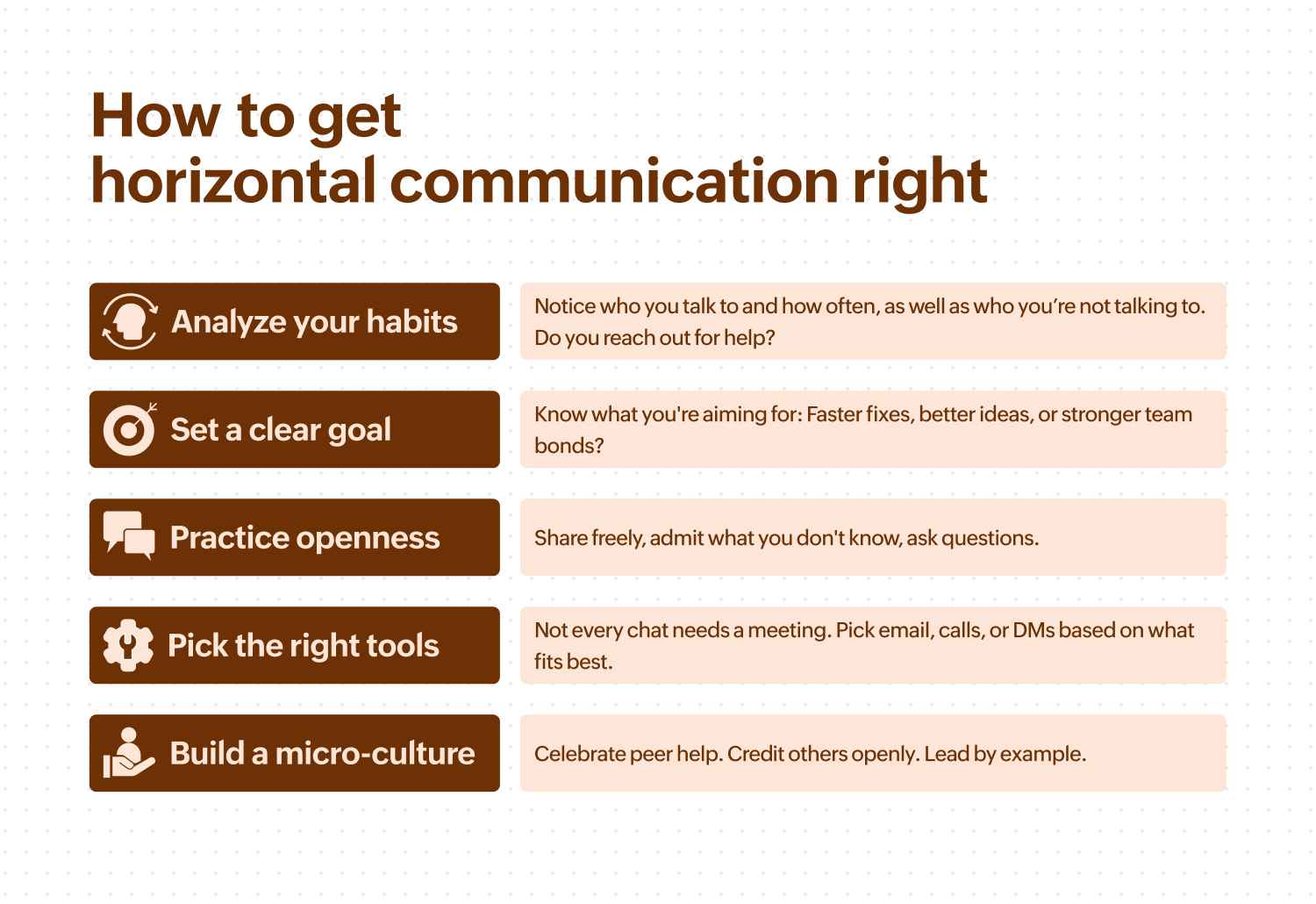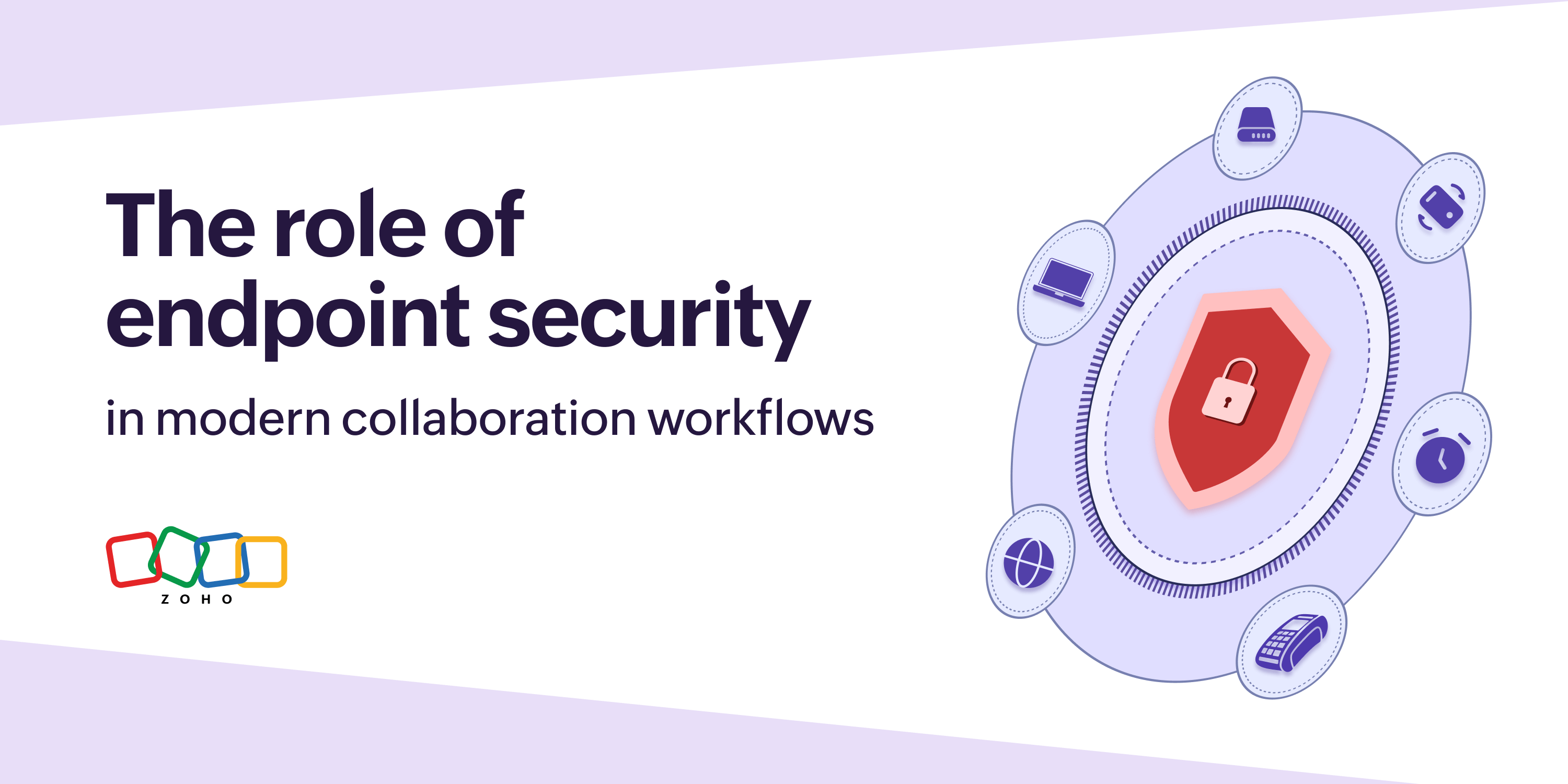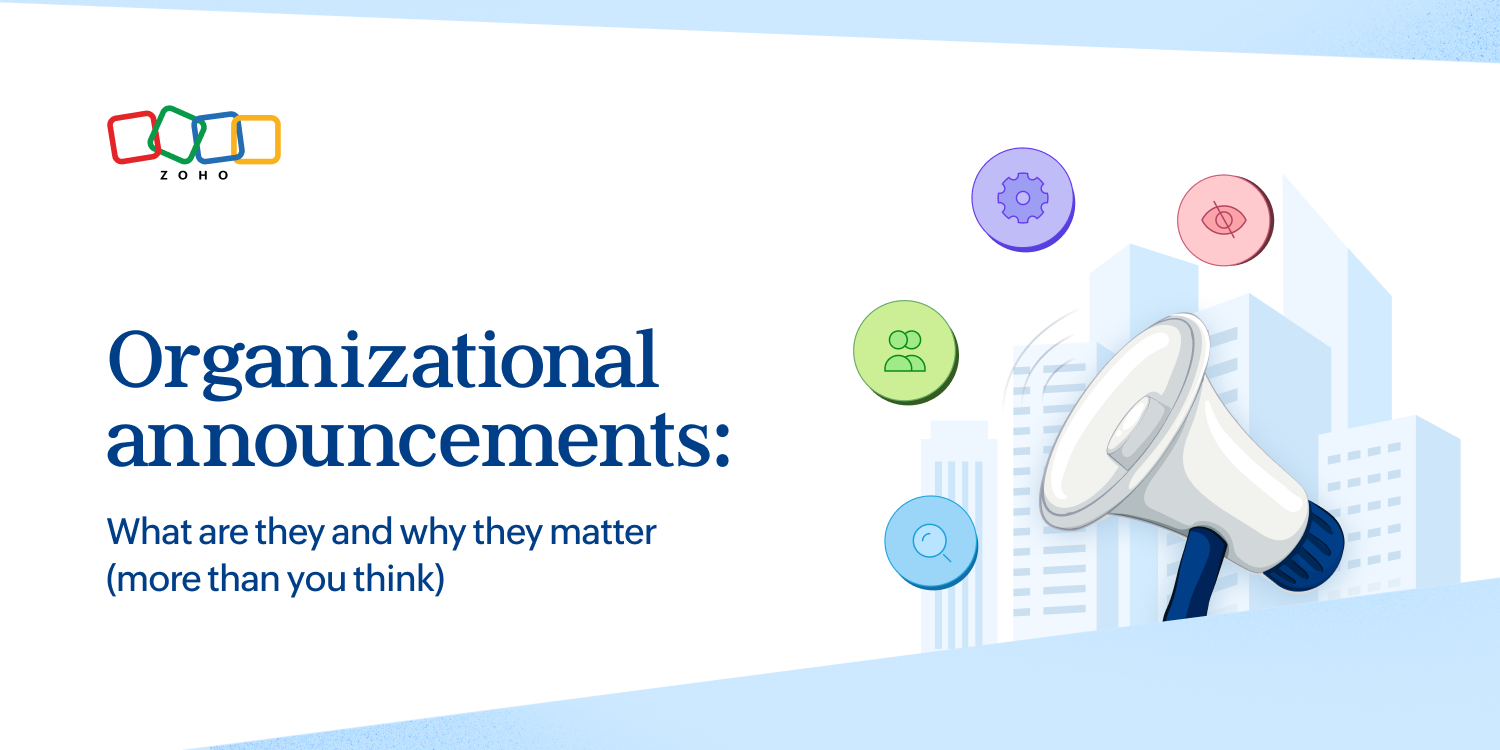- HOME
- All Products
- Collaboration
- Horizontal communication: Why it matters, and how to do it right
Horizontal communication: Why it matters, and how to do it right
- Published : June 30, 2025
- Last Updated : July 1, 2025
- 3.9K Views
- 6 Min Read
Horizontal communication. It sounds like something you'd find buried on page 54 of a big book of corporate buzzwords, doesn't it? Right between chapters on “synergy at the workplace” and “touch base like a total boss.”
But don't let that intimidate you. Despite the fancy name, you're probably already doing it. Yes, you are. Every time you roll your chair over to ask a colleague a question, send a quick email to someone on your team, or grab a coffee with a peer to discuss a project, you're horizontally communicating.
In this article, we’ll break down what horizontal communication is, why it’s a game-changer, and why it’s sometimes tricky to pull off. We’ll also explore common ways it happens, how to nail it, and give you a list of fresh, actionable steps to get started, whether you’re an individual contributor or a team leader. Let’s dive in.

What is horizontal communication?
It's the kind of communication that happens between people on the same level. They may be your team member and peer. If you're a manager, it could be the manager of another team. It could be a member at the same level in another team. There is no obligation to report to anyone else here.
Examples of horizontal communication
So, what does horizontal communication look like in the wild? It’s everywhere if you squint hard enough.
Here’s what it looks like in real life:
- Two developers hashing out a coding snag over a chat app.
- A sales manager swapping strategies with a marketing manager.
- Team members from different departments tossing ideas around at a lunch table.
In small teams, this happens naturally. You talk, figure things out, and move on. But as teams grow, people stop talking. Everyone's too busy replying to their manager's emails or sitting in meetings that should've been emails. Unless they’re talking about that annoying employee, because bonding through trauma is the strongest glue.
When the communication stops, that's when things fall apart like Jenga blocks.
Advantages of horizontal communication
Here's the thing about communicating with your peers: information isn't hoarded at the top anymore. Everyone has pieces of the puzzle. That colleague in marketing may know exactly how to solve the problem you've been wrestling with all week. The person in customer service has insights that could completely change your product development approach.
Two heads really are better than one, especially when both heads are dealing with similar day-to-day challenges. Your peers understand your world in a way that your boss (who's two levels removed from the actual work) may not. They've been in the trenches with you, shoulder to shoulder. They get it.
Here’s the bonus: It turns your colleagues into actual teammates, not just random names on a Zoom call. You build trust, share the load, and suddenly work feels less like work and more like a group effort worth showing up for.
Why it can be tough to start
1. There’s no obligation.
The biggest reason that makes horizontal communication both powerful and frustrating is that nobody's making you do it. With vertical communication, there's a clear chain of command. Your boss gives you direction; you respond. There are expectations and consequences. Horizontal communication? That's entirely optional. And that's precisely why so many people skip it, even when it would make their lives easier.
2. There’s too many organizational silos.
Some companies are structured in a way that naturally discourages cross-functional interaction. Teams have their own goals, budgets, and cultures, making it feel like crossing a border to talk to someone from another area. Besides, there is a "perceived" competitiveness in environments like this.
3. It takes time and effort.
Finally, there's the perception of time. We’re all busy, and it’s easy to view a casual chat as an unproductive distraction. People chalk it up to "water cooler talk" and generally frown upon it. It also takes a bit of initiative, and this seemingly looks like a wasted effort.
What are some common methods of lateral communication?
Horizontal (also known as lateral) communication doesn't require fancy tools or formal processes. It happens through the channels you're already using.
Informal gatherings like team lunches, coffee breaks, and those spontaneous conversations by the water cooler. Sometimes the best ideas happen as you’re refilling your bottle or grabbing a snack.
Chat apps like Zoho Cliq or any messenger app where you can ping someone, attach a screenshot, and watch that little read-receipt pop up.
Internal forums or intranet boards where you post guides, solutions, or shoutouts for cool hacks you’ve discovered.
Digital channels like emails and direct messages. When you need to lay out details or share files, you slide into someone’s inbox (ideally at a sane hour!)
How to get horizontal communication right
The tricky part about horizontal communication is that it requires intention without feeling forced. You can't mandate peer collaboration the way you can mandate attendance at team meetings. It has to feel natural.
Start by analyzing what you're already doing. How often do you reach out to colleagues? When problems arise, is your first instinct to figure it out alone or to ask for input? Are there people in your organization whose expertise you're not tapping into?
Get clear on what you want to achieve. Are you looking to solve specific problems faster? Generate more creative solutions? Strengthen your teamwork? Understanding your goals helps you communicate more purposefully.
Embrace openness. This means admitting when you don't know something, sharing resources that might help others, and being genuinely curious about what your colleagues are working on. It's harder than it sounds in competitive work environments, but it's essential.
Use the right tools for the job. That meeting that could've been an email? Turn it into an email. That email that could have been a quick call? Pick up the phone.
Create a culture of openness around you. Even if the whole organization hasn't caught up yet, practice it on your own. Celebrate when colleagues help each other. Share credit generously. Make it clear that collaboration is valued, not just individual achievement.

Actionable steps to start horizontal communication
Here are some simple, non-clichéd things you can try today.
If you're an individual:
Schedule a "Curiosity Coffee": Once a week, invite one person from outside your immediate team for a 15-minute virtual or in-person chat. The only agenda? "I'm curious about what you're working on." Maybe have a coffee while you're at it.
Amplify credit: When you see a great idea or helpful piece of information in a private chat, ask the person if you can share it in a more public team channel. Give them full credit. That’s how good ideas travel.
Ask for low-stakes feedback: Before you're 90% done with a project, share a very early draft with a trusted peer and say, "Could you give this a quick read? No need for a deep dive." This makes giving feedback less intimidating.
If you're a team leader:
Reach out casually: Start conversations with other team leads informally. A quick DM, a spontaneous chat about a hiccup. Strictly no calendar invites.
Ask for input early: When you’re planning something or facing a tricky decision, check in with another team lead on how they are handling it. It also shows your team that you value peer-to-peer problem solving.
Share freely, without expectation: If you have a process update or a quick lesson from your team’s recent sprint, pass it along to your peers. The trust you build doing this pays off.
Wrapping up
When horizontal communication works well, it creates a ripple effect throughout your organization. Most importantly, work becomes more human. Instead of feeling like isolated cogs in a corporate machine, people feel like part of a community where colleagues are resources, allies, and sometimes even friends.
The irony is that horizontal communication, despite its corporate-sounding name, is actually about making work more natural and effective. It's about recognizing that your colleagues are some of your most valuable resources and that the best solutions often come from simple conversations between people who understand each other's challenges.
 Srinath Vijayakumar
Srinath VijayakumarSrinath is a product marketer for Zoho Workplace. He talks about productivity, tips to improve communication, and nuggets on doing your best at your workplace. He has great interest in bringing a fresh perspective to the forefront. He is highly optimistic to the extent that he opens the refrigerator every 10 minutes, hoping to find something new. Outside of work, you will catch him playing football, travelling or writing half-finished stories.


